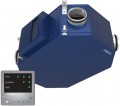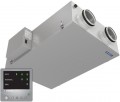Maximum noise level
The noise level produced by the air ventilation unit in normal operation.
This parameter is indicated in decibels, while the decibel is a non-linear unit: for example, a 10 dB increase gives a 100 times increase in sound pressure level. Therefore, it is best to evaluate the actual noise level using special tables.
The quietest modern ventilation units produce about
27–30 dB — this is comparable to the ticking of a wall clock and allows you to use such equipment without restrictions even in residential premises (this noise does not exceed the relevant sanitary standards). 40dB is the daytime noise limit for residential areas, comparable to average speech volume. 55–60 dB — the norm for offices, corresponds to the level of loud speech or sound background on a secondary city street without heavy traffic. And in the loudest, they give out 75–80 dB, which is comparable to a loud scream or the noise of a truck engine. There are also more detailed comparison tables.
When choosing according to the noise level, it should be taken into account that the noise from the air movement through the ducts can be added to the noise of the ventilation unit itself. This is especially true for centralized systems (see "System"), where the length of the ducts can be significant.
Heat exchanger efficiency
Efficiency of the heat exchanger used in the heat exchanger of the supply and exhaust system (see "Features").
Efficiency is defined as the ratio of useful work to the energy expended. In this case, this parameter indicates how much heat taken from the exhaust air, the heat exchanger transfers to the supply air. The efficiency is calculated by the ratio between the temperature differences: you need to determine the difference between the outdoor air and the supply air after the heat exchanger, the difference between the outdoor and exhaust air, and divide the first number by the second. For example, if at an outside temperature of 0 °С, the temperature in the room is 25 °С, and the heat exchanger produces air with a temperature of 20 °С, then the efficiency of the heat exchanger will be (25 – 0)/(20 – 0)= 25/20 = 80%. Accordingly, knowing the efficiency, it is possible to estimate the temperature at the outlet of the heat exchanger: the temperature difference between the inside and outside must be multiplied by the efficiency and then the resulting number is added to the outside temperature. For example, for the same 80% at an outdoor temperature of -10 °C and an internal temperature of 20 °C, the inflow temperature after the heat exchanger will be (20 – -10)*0.8 + -10 = 30*0.8– 10 = 24 – 10 = 14 °C.
The higher the efficiency, the more heat will be returned to the room and the more savings on heating will be. At the same time, a highly efficient heat e...xchanger is usually expensive. Also note that the efficiency may vary slightly for certain values of the external and internal temperatures, while manufacturers tend to indicate the maximum value of this parameter — accordingly, in fact, it may turn out to be lower than the claimed one.
Power consumption in ventilation mode
The electrical power consumed by the supply and exhaust unit in normal operating mode (for models with adjustable performance — at maximum speed) can help determine the connection requirements for the unit and estimate the cost of operation in terms of electricity bills. It should be noted that for models with an electric reheater (see "Reheater type"), this refers only to the power of the ventilation system, while the power of the reheater is provided separately (see above). Therefore, the total energy consumption during full operation will correspond to the sum of these power values.
The power consumption can also be used to some extent to assess the unit's performance: "power-hungry" units usually provide a corresponding airflow.

